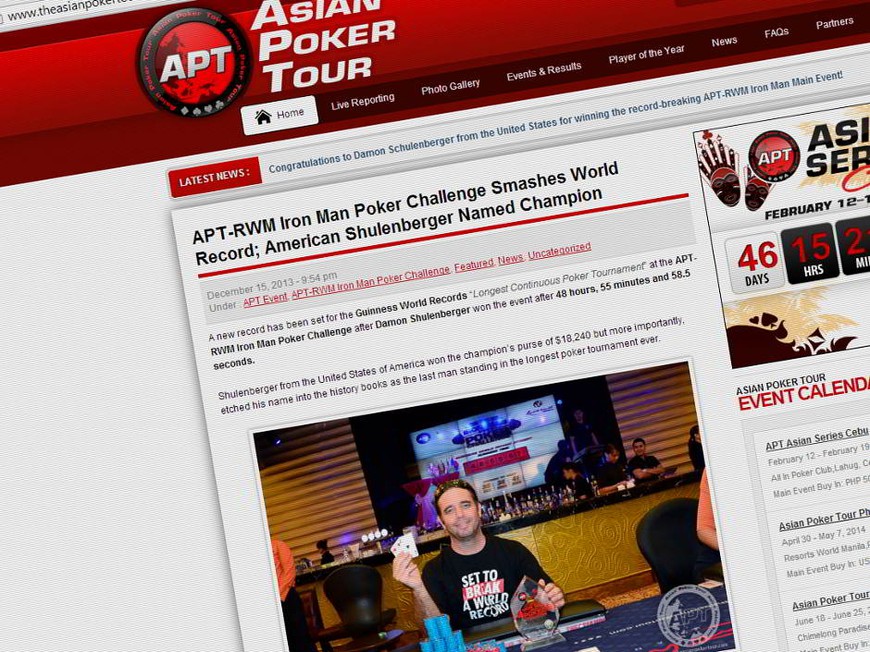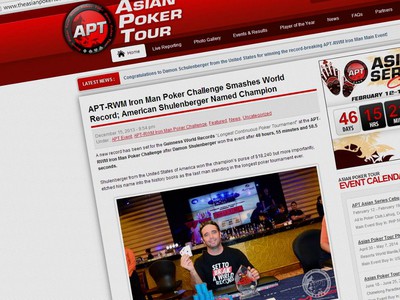

- Damon Shulenberger details the 49 hours leading to his victory in the historic 2013 APT-RWM Iron Man Poker Challenge.
On December 15, after nearly 49 hours of continuous play, I was declared winner of the first-ever Asia Poker Tour – Resorts World Manila (APT-RWM) Iron Man Poker Challenge. When all was said and done, I had been engaged in continuous play from 8:30pm Friday night until 9pm Sunday night, with only bathroom breaks away from the table. This uniquely structured tournament, with its accompanying lapses of consciousness and reason, represented one of the most challenging undertakings of my poker career. It was also one of the most satisfying.
Just ten minutes before my arm was raised by Iron Man Poker Challenge tournament director Lloyd Fontillas in a euphoric moment that I was barely alive enough to enjoy, my opponent of the past four hours Choi Byung Kyoo had announced in raspy, barely audible English, that he was going all-in on every hand from here on out.
Forget strategy, in a game where deals were not allowed and the difference between first and second was more than $7,000. My worthy opponent, like many others before him, had a compelling reason for this decision––a business flight to Korea that he was in danger of missing. Moreover, he was in imminent danger of dropping flat on the table, felted by biological necessity after some 20-odd grueling rounds of continuous poker.
A little bit about myself––originally from California, I have lived on and off in the Philippines for the past two years. I left the world of online poker following the Full Tilt debacle of 2010 (I was admittedly fighting withdrawal symptoms for quite some time), and have been strictly a brick-and-mortar player since. Poker in the Philippines’ provincial second city is an often vocal affair typically involving locals, Western expats, and Koreans. Life here in the horse latitudes seems a couple decades behind the times, and that is a part of the appeal. A freelance writer by trade, rather than trying to support myself through poker, I have focused on studying players and the way they act in certain situations––with an ultimate goal of becoming a major tournament threat.
The APT events always bring together a few familiar faces from Cebu, as well as a host of Manila grinders, and poker aficionados from throughout Malaysia, Korea, Singapore, and Japan. The competition level is surprisingly intense, with many of the best Asian players exceptionally aggressive––their unrelenting willingness to put it all on the line with nothing but an ice cold stare makes a suck-out (or three) inevitable over the course of any tournament. Prior to the Iron Man, I had never won any of the APT events, but had made the final table in some side tournaments, earning a certain amount of respect among regulars.
I came into the Iron Man with not the slightest idea of what the event involved, except that it was nominally about Guinness Book of World Records glory. I was also vaguely aware that it mirrored a worldwide trend in extreme workouts (CrossFit) and obstacle courses (Tough Mudder) and would have a significant quotient of pain involved. I can now report that the structure has its roots in a 2009 tournament designed by sicko Commerce Casino tournament director Matt Savage. The aim was to bring a bit of suffering and privation to today’s coddled players, who can only dream about life as a Road Warrior, traveling the backroads of oil-boom Texas, looking at their cards bleary-eyed down the barrel of a shotgun.
If inflicting maximum pain was the intent, I can attest that the 2013 Iron Man exceeded all expectations. Players in the inaugural 2009 event were given a paltry 10,000 chip starting stack, with play lasting a respectable (but less-than-incredible) 19 hours and 21 minutes. In 2012, a new record of 36 hours, 34 minutes was set at the Delaware Park Ironman Poker Challenge. Not to be outdone, the Machiavellian schemers at the APT concocted a structure-to-end-all structures: 100,000 starting chips with 25/50 starting blinds. One hour levels replaced by 1.5 hour levels after the 10th round, and 2 hour levels beyond the 20th round.
The event was recorded for posterity and had a number of officials on hand (including mute observers with “witness” signs hanging from their necks) to ensure integrity of the game. Also on hand was a table of paramedics, presumably to ensure rapid response should a player lose consciousness or go into pizza-induced cardiac arrest.
I sat down at 8:30pm, about halfway through the first round, having done my best to catch some zzz’s that afternoon. The first shock was the stack size: I had come to the tournament unprepared for a stack and blind structure designed specifically (as it gradually dawned on me) to extend play as long as humanly possible. Play was tentative at first, with players sussing each other out and preemptively yawning, stretching, and grumbling about how late the tournament had started. As the song goes “you ain’t seen nothin’ yet.” This was the quiet before the storm, with players still not battle-tested at the front lines of sleep deprivation. With 100,000 chips behind, even major hands represented only 5 to 10 percent of any given player’s stack.
As the mornnight (as they call it in the Philippines) wore on, I transferred to a much more active table of mostly locals who seemed intent on bluffing off as many chips as possible. When they inevitably started discussing strategy in the local lingo following every major hand, I asked half-jokingly if I could join the club.
Playing tight to the vest, I had 80,000 behind at around 4am when I finally doubled up. Having raised AJ pre-flop and gotten a call from a crafty Singaporean player (who had won a previous APT side-event), I bet out when an ace hit the flop. My opponent’s smooth call alerted me that I was quite possibly behind. I checked the turn and my foe put in a pot-sized bet of 10,000. I talked myself into a marginal call I could not have afforded in a normal tournament. If I failed to hit a jack, I still had 50,000 behind (about 100 big blinds) and an easy fold.
When a jack peeled out on the river I shoved all-in. After surprisingly little thinking time, the Singaporean called and showed AK. Thirty minutes later he was out of the tournament, the victim of his own pre-river timidity and post-river overvaluing of AK. In the next couple hours, I brought my stack up to a very respectable 200,000 simply by calling down bets with “bluff catcher” second pairs against my overly aggressive table mates.
Moving to another table around 6am, I was fortunate to catch a couple Korean players in the throes all-encompassing fits of rage and tilt. Whatever history underpinned the bad blood at the table, I was glad to play the role of neutral mediator and relieve them of their chips. The cobwebs of the early morning dissipated with a few sets of pushups and energy drinks, and I was humming along with a rather sizable stack when I moved to a new table around noon.
This table had a distinctly British accent and, over the next few hours, there were quite a number of small-stacked players to be pleasantly picked off (sorry, old chap). There was also a major hand in which I had KQ, and flopped KQ on a Q-K-10 board. I called a major raise by my super-aggressive Singaporean opponent and hit a boat with a king on the turn. After the expected pot-sized bet, I pushed all in. My opponent eyed me down for 10 minutes or so before ultimately folding, claiming that he held a Q-10.
Whether it was indeed Q-10 or air, I was not surprised to see him fritter away his substantial stack shortly before we got into the money, coming away with nothing to show for 20 some-odd hours on the felt. Take away––super aggressive play may get you far in tournaments where blinds are exerting major pressure, but will kill you within an Iron Man-type structure where (much like cash play) patience is rewarded.
Another noteworthy mid-tourney hand involved a little posturing on my part that (literally) put the fear of God into opponents. While I did not sell my soul to the devil, I was not above using underhanded tactics to enhance my image on the felt. When 6-6-6 came out on the flop, I casually commented that the tourney had commenced on Friday the 13th. I may also have let it slip in the same breath that my name is Damon. It is a peculiar happenstance that the American pronunciation of “Damon” corresponds with how Filipinos pronounce “demon,” and I frequently get startled glances from laundry shop clerks and Starbucks baristas in heavily Catholic Manila. Knowing that this would have its desired effect on at least a few of the players at the table, I remember taking a hefty pot with a well-timed raise in this particular pot.
In the hours leading up to the money (top 18), I wound up at an extremely challenging table. Key among my opponents was Samad Razavi, a girthy English fellow who was crowned APT Player of the Year for 2013, his second time to win the coveted award. His charming wife Maria Carmen Esdaile (who was quite pregnant) also played the Iron Man and was Player of the Year runner-up. I had knocked her out a few hours ago after some enjoyable chat, while she nursed a dwindling stack.
Anyway, this fellow turned out to have a gladiatorial style and threw chips onto the table with an almost physical force that made each round of betting seem like a throw-down. He and his cohort Howard Ang Lee (affectionately known as “Howard the Duck”) had been at the table together for quite a while and had an effective system of large raises from UTG (with air), designed to take chips from timid players who were afraid of landing outside the money.
At first I held back and sussed Mr. Razavi out, and then I began to take stabs at pots, and finally to fight fire with fire. The bubble is no time for meek play and with the blind structure the way it was, anything between the 300,000-700,000 chips I fluctuated within was enough to make a serious run at the money. As it turned out, active play was the correct strategy, as it took us more than an hour to make it down from 19 players to 18. Particularly surprising was the resilience of the short stack at the next table, a rail-thin German guy whom everyone kept expecting to bust out. Sandro Simon somehow hung in there and the next time I encountered him was on the final table, where he was one of the chip leaders.
At around the 30th hour the bubble finally burst and we consolidated to two tables. Stacks were still enormous relative to the blinds, so we would expect to see some tight play to the bitter finish, right? Actually, nothing could be further from the truth. With the next nine payouts ranging from $1320 to $1870, players decided en masse that just a few hundred dollars reward for the equivalent of four days work was about right. I don’t know about other countries, but in the U.S. that kind of money is slightly above minimum wage.
Despite an incentive for cool, calculated play, the two tables folded to one in a record 2.5 hours. Player after deep-stacked player succumbed to the rookie mistake of overplaying marginal hands into all-in shoves and calls. It was as if need for sleep convinced people that leaving with just a little money in their pockets was fine, as long as they got some much needed zzz’s. I nearly fell into the same trap, as my head was beginning to feel as if it was swimming in a fishbowl. Money, what is that really compared with a hot shower and a nice warm bed?
The wreckage at the other table was far greater, as a young Singaporean Zhang Quaosheng, who had seemed conservative and rational 12 hours ago, went all in repeatedly with marginal hands. His excuse was that he had a flight to catch and work to prepare for, although I chalked it up (as with nearly everything at this befuddling tournament) to lack of sleep. Amazingly, Zhang donked out against three or four players in a row, in the process earning chip leader status. Failing to shift gears, his downfall was just as rapid and he was ultimately sent home packing in 12th place. To his credit, Zhang took it all with a cosmic shrug––which I could not say for Samad Razavi, who nearly knocked everyone’s chips off the table when he was felted in 11th. I could not entirely blame him––when you have invested a full day of your life in a tournament, to land outside of the real money and take home a few hundred dollars feels like a crushing defeat.
Just prior to hitting the final table, I had one pivotal hand, in which my JJ held up against the all-in of a player with AK, with 50 percent of my stack at stake. This hand boosted me up to about 1.5 million chips and ensured that I would be one of the larger stacks as we moved toward the real money.
In part two, Damon Shulenberger highlights some of the hands and psychological warfare that helped him endure and finally overcome the historic marathon that was the 2013 APT-RWM Iron Man Poker Challenge.

